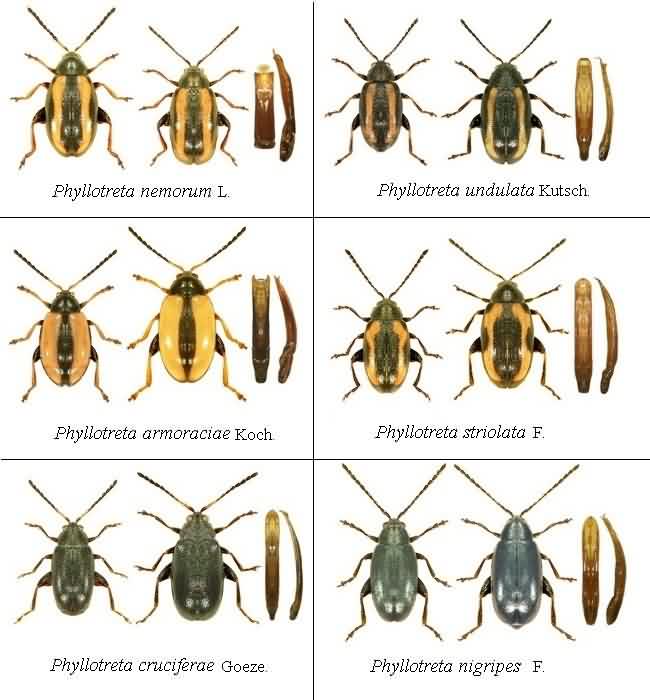Pests
Phyllotreta nemorum L., Ph. undulata Kutsch., Ph. atra Fabr., Ph. cruciferae Goeze., Ph. nigripes F., Ph. armoraciae Koch., Ph. striolata F. - Cabbage (Crucifer) Flea Beetle.
Systematic position.
Class Insecta, order Coleoptera, family Chrysomelidae, genus Phyllotreta Stephens.Synonym.
Ph. vittata F. is a synonym of Ph. striolata F.Biological group.
Pest of vegetables of the family Cruciferae.Morphology and biology.
Body length of Phyllotreta nemorum reaches 2.5-3 mm; Ph. undulata reaches 1.8-2.5 mm; Ph. armoraciae reaches 3-3.5 mm; Ph. striolata reaches 1.8-2.2 mm; Ph. atra reaches 1.7-2.6 mm; Ph. cruciferae reaches 1.8-2.5 mm; Ph. nigripes reaches 1.8-2.8 mm. Body slightly convex, elongated, oval. Upper side of Ph. nemorum, Ph. undulata, Ph. armoraciae, and Ph. striolata is black, bronze or blue-metallic, with yellow stripes or spots on elytra. Ph. armoraciae has broad yellow stripe on elytron, which covers humeral prominences. Ph. striolata has narrow yellow stripe on elytron with semi-circular excision in the middle part of the outer edge. Ph. nemorum with mostly punctated occiput; head and pronotum with cyanic shine; yellow stripe on elytron is curved toward suture in basal and apical parts, with straight inner margin. Ph. undulata has similar pattern on elytra, but inner edge of yellow stripe is distinctly emarginated, occiput without punctures, head and pronotum black. Ph. atra, Ph. nigripes, and Ph. cruciferae have monochrome, black elytra. Ph. atra with punctated frons and occiput, upper side of body without metallic shine. Ph. cruciferae has metallic-green upper side of body; 2nd and 3rd segments of antennae do not differ in color. Ph. nigripes has the same color as previous species; 2nd and 3rd segments of antennae reddish, lighter than other segments. Adults hibernate in forest belts under leaf debris or in soil and sod at a depth of 10 cm. In spring, adults appear starting at the end of April. They skeletonize leaves of host plants and injure stems and pods. Flying begins when air temperatures reach 14-16°C. Fertility is about 40 eggs. Hatching lasts 3-14 days. Ph. armoraciae lays eggs near root neck of the host plant, and larvae bore into leafstalk. Ph. nemorum lays eggs on the leaf surface, and larvae mine leaves after hatching. Larvae in last instar dirty-white in color, head and last segment light yellow. Remaining species lay eggs in the soil around host plants; larvae, after hatching, eat fine roots and develop over 14-21 days. Pupation occurs in soil and lasts 8-14 days.Distribution.
Ph. striolata and Ph. armoraciae are holarctic species. Ph. atra, Ph. nemorum, and Ph. undulata are transpalearctic species. Ph. nigripes is distributed throughout Europe, Northern Africa, and Asia Minor. In the former USSR, Ph. nigripes inhabits the European region, the Caucasus, Southwestern Siberia, Kazakhstan and Central Asia. Ph. cruciferae is distributed throughout Europe, Northern and Eastern Africa, Asia Minor, and Afghanistan. In the former USSR, Ph. cruciferae inhabits the European region, the Caucasus, Southern Kazakhstan, Kirgizstan and Tajikistan.Ecology.
Oligophagous species. In temperate climates, they are monovoltine, perhaps bivoltine and trivoltine in southern territories. Optimum temperature for adult feeding is 18-25°C. Adults leave host plants and move to soil after temperature falls. Humidity is important for oviposition only. Development of pests is possible on weed plants, such as Berteroa incana, Sisymbrium officinale, Thlaspi arvense, Lepidium draba, Alliaria officinalis, Capsella bursa pastoralis, Crambe tatarica, etc. The Ph. nemorum population density depends on the activity of parasitic larvae and adults of Nematodes and parasitic larvae of Diospilus morrosus Reinh. (Braconidae).Economic significance.
Ph. undulata, Ph. cruciferae, Ph. nigripes, Ph. nemorum, Ph. atra, and Ph. striolata damage many crucifer plants. Ph. striolata mainly damages mustard and rape, while Ph. armoraciae damages horseradish. Control measures include using fertilizers to accelerate seedling development and pre-sowing treatment of seeds with systemic pesticides. Pesticide treatment is necessary in spring after mass emergence of beetles after hibernation. Control measures on turnip and black radish include sowing at the latest possible time.Related references:
Dubeshko, L.N. & Medvedev, L.N. 1989. Ecology of leaf beetles of Siberia and the Far East. Irkutsk: Irkutsk University. 224 p. (in Russian).Kopaneva, L.M., ed. 1982. Keys to harmful and useful insects and mites on the vegetable plants and potato in the USSR. Leningrad: Kolos. 272 p. (in Russian).
Kostromitin, V.B. 1980. Cabbage flea beetle. Moscow: Kolos. 63 p. (in Russian).
Lopatin, I.K. & Kulenova, K.Z. 1986. Leaf beetles (Coleoptera, Chrysomelidae) from Kazakhstan. Alma-Ata: Nauka. 199 p. (in Russian).
Lopatin, I.K. 1977. Leaf beetles (Chrysomelidae) of Middle Asia and Kazakhstan. Leningrad: Nauka. 289 p. (in Russian).
Medvedev, L.N. & Ammosov, Yu.N. 1978. Fauna of leaf beetles (Coleoptera, Chrysomelidae) and the cardinal zoogeografical peculiarities. Ecofaunistical investigations of insects from Yakutia. Yakutsk: Yakutsk filial SO AN SSSR. P. 113-128. (in Russian).
Palii, V.F. 1961. Fauna of pest flea beetles of the USSR. Frunze: AN Kirgiz.SSR. 101 p. (in Russian).
Putele, V. 1970. Fauna of flea beetles of Latvian SSR. In: Materials of 7th Baltic meeting on plant protection (part 2). Pests of agricultural and forest plants and their control. Elgava: Latvian Ministry of Agriculture, p. 17-20 (in Russian).
Shapiro, D.S. 1961. Fauna of flea beetles of the genus Phyllotreta Stephens of the European part of the USSR (Coleoptera, Chrysomelidae, subfam. Halticinae). In: Questions of genetics and zoology. Kharkov: Khar'kov GU. P. 82-107 (in Russian).
Shutak, V.I. 1973. Numerous pest flea beetles of Bashkiria and Southern Ural region. In: Science for production (collection of works). Voronezh: Minsel'khoz, p. 85-88 (in Russian).


